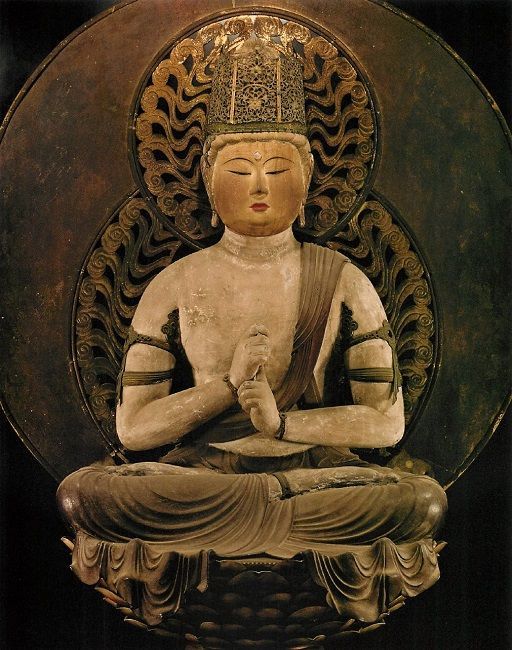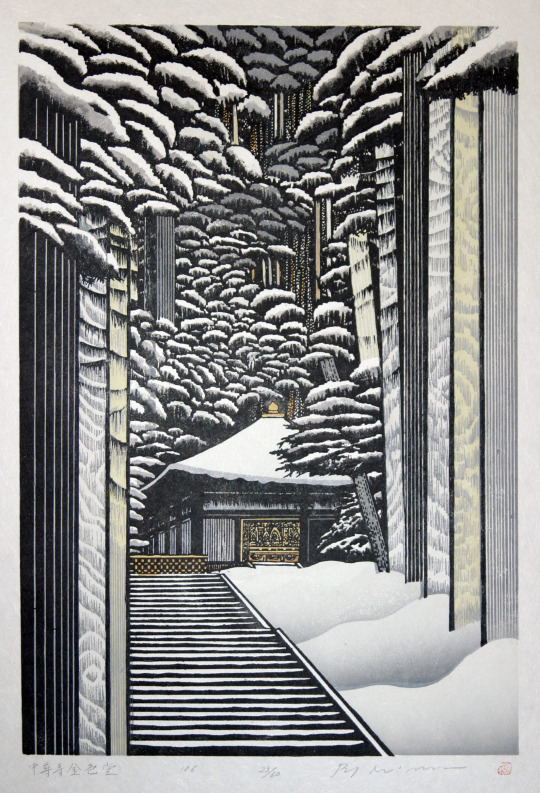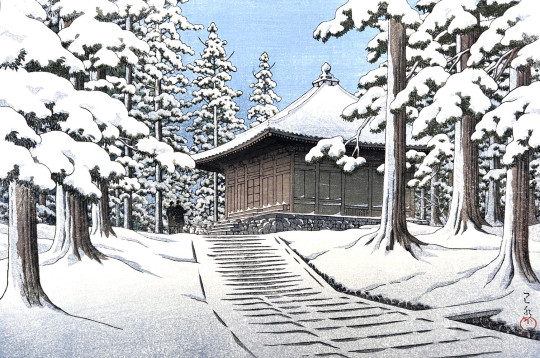#Chusonji-temple
Photo

Legends and myths about trees
Trees in Buddhism (3)
The Golden Wheel King – Maitreya appearing once every 3,000 years with the the flowers of the udumbara (Ref)
His body colour is gold, crowned with a crown of seven treasures, and light emanates from its entire body. He makes a sign and sits in the full lotus position on a lotus flower decorated with the seven treasures. The lotus flower on which he is seated has a jeweled crown and a treasure pond beneath it.
The most outstanding of the Wheel-Turning Kings, the Golden Wheel King, has an extremely superior merit of the buddhosnisa (the superior brain of Tathagata, the divinity of the intellect to save people).
According to the description in the Buddhist scriptures, the concept of the Wheel-Turning King (Pali: chakravarti, Skt. cakravartin) was roughly as follows.
The world goes through cycles of prosperity and decline. In times of prosperity, the human lifespan is 80,000 years, but as human virtue is lost, the lifespan becomes shorter, and in the age of darkness, when all good is lost, it is 10 years. Thereafter, human virtue is restored, and once again we enter the age of prosperity, when the lifespan is 80,000 years.
It is during this age of prosperity that the transmigration of the Wheel-Turning King will emerge, as a result of his good deeds in his previous lives. He has the same 32 auspicious signs (Ref), signifying a great being like the Buddha, and rules the earth up to the four oceans with the power of the law, without using force of arms.
There are 4 types of Wheel-Turning Kings: the Golden Wheel King, the Silver Wheel King, the Bronze Wheel King, and the Iron Wheel King. The Iron Wheel King has the Iron Wheel and rules over one of the 4 continents that were considered to exist on the earth in the ancient Indian worldview. Likewise, the Copper Wheel King has the Copper Wheel and rules over two continents, and the Silver Wheel King has the Silver Wheel and rules over three continents. The Golden Wheel King, the highest Wheel-Turning King, has the Golden Wheel and rules all 4 continents. For this reason, the Golden Wheel King, like the Wheel-Turning Kings, is surrounded by his seven attributes.
The seven treasures and four divine virtues of the Wheel Turning Sage King:
Chakraratna wheel: rolls in all directions and makes the king level the earth.
Elephant treasure (hatthiratana): a pure white elephant that also flies in the sky.
Horse treasure (assaratana): pure white horses that also fly in the sky.
Octagonal gem treasure (maniratana): jewels whose luminous emanations can reach as high as 1yojana (7mi/12–15 km).
His queen (itthiratana): a dutiful and chaste queen with good looks and fragrance.
Finance minster (gahapatiratana): wealthy citizens who support the state.
General treasure (parinayakaratana): a wise, capable and skilled general.
They are also said to possess the four divine virtues:
good looks
long life
Fewer illnesses, fewer worries
Respect from Brahmin Gahapati and compassion for them

木にまつわる伝説・神話
仏教の樹木 (3)
金輪王 (こんりん‐おう) 〜 3000年に一度、うどんげの花(参照)とともに現れる弥勒菩薩
体色は金色で七宝冠を戴き全身から光を放つ。印を結んで七宝で飾られた蓮の花の上に結跏趺坐する。座っている蓮華の下に輪宝、さらにその下に宝池がある。
転輪聖王のうち最も優れた金輪王は、仏頂尊 (如来の優れた頭脳、人々を救済する知性を神格化したもの)の霊験が極めて優れている。
仏典の記述によれば、転輪聖王 (てんりんじょうおう、転輪王とも)の概念とは大まかに以下のようなものであった:
世界は繁栄と衰退の循環を繰り返し、繁栄の時には人間の寿命は8万年であるが、人間の徳が失われるにつれて寿命は短くなり、全ての善が失われた暗黒の時代には10年となる。その後、人間の徳は回復し、再び8万年の寿命がある繁栄の時代を迎える。
転輪聖王が出現するのはこの繁栄の時代であり、彼は前世における善行の結果、転輪聖王として現れる。ブッダのような大いなる存在を意味する32の希少で特別な身体的特徴(参照)を持ち、4つの海に至るまでの大地を、武力を用いる事無く、法の力を以って統治する。
転輪聖王には金輪王、銀輪王、銅輪王、鉄輪王の4種類がある。鉄輪王は鉄の輪宝を持ち、古代インドの世界観で地球上に4つあるとされた大陸のうち、1つの大陸を支配する。同様に銅輪王は銅の輪宝を持ち、2つの大陸を、銀輪王は銀の輪宝を持ち、3つの大陸を支配する。そして最上の転輪聖王である金輪王は、金の輪宝を持ち、4つの大陸全てを支配するという。そのため金輪王の周りには、転輪聖王が従えるという七つの宝が配置されている。
転輪聖王は七種の宝と徳性を持つと言う:
輪宝 (チャッカラタナ): 四方に転がり、王に大地を平定させる
象宝 (ハッティラタナ): 空をも飛ぶ純白の象
馬宝 (アッサラタナ): 空をも飛ぶ純白の馬
珠宝 (マニラタナ): 発する光明が1由旬(12–15 km)にも達する宝石
女宝 (イッティラタナ): 美貌と芳香を持つ従順かつ貞節な王妃
居士宝 (ガハパティラタナ): 国を支える財力ある市民
将軍宝 (パリナーヤカラタナ): 賢明さ、有能さ、練達を備えた智将
また四種の神徳を持つと言う:
美貌
長寿
少病少悩
バラモン・ガハパティからの敬愛と彼らに対する慈愛
#wheel turning kings#golden wheel king#maitreya#buddism#7 treasures#4 divine virtues#trees in buddhism#udumbara#golden hall#Chusonji-temple#philosophy#nature#art
121 notes
·
View notes
Text

Kawase Hasui (1883-1957)—Konjiki Hall of Chusonji Temple, Hiraizumi [woodblock print, 1935]
874 notes
·
View notes
Photo

MORIMURA Ray/Rei(森村玲 Japanese, b.1948)
中尊寺金色堂 Chusonji Temple Golden Hew Pavilion 2006 woodblock print via
2K notes
·
View notes
Photo

Lotus Sutra / late 12th century/ Japanese
Opening with an illustration, this handscroll of the Lotus Sutra was part of a larger body of work copied or commissioned by members of the court as a means to salvation. The indigo color stands for the mineral lapis lazuli, which, like gold and silver, is part of the seven treasures of Buddhism. Illuminated sutras are believed to have been dedicated by the Fujiwara clan to Chusonji Temple in the northeast region of Japan.
Handscroll; gold and silver on indigo dyed paper, 3940 15/16 × 9 3/4 in. (10010 × 24.8 cm); width with knobs: 11 1/2 in. (29.2 cm)
Seattle Art Museum
121 notes
·
View notes
Text

Kawase Hasui (1883-1957) Chusonji temple, from the Calendar for the Pacific Transport lines (December), 1953.
Via @atomicker at Mastodon:
4 notes
·
View notes
Text
chusonji temple, iwate, japan

At the beginning of the 12th century, large-scale temple construction was carried out by Fujiwara no Kiyohira, the founder of the Northern Fujiwara clan. The temple was built to placate souls of all who died in the Former Nine Years War and the Latter Three Years' War. Kiyohira, who had been forced into bloody battles and lost his family in the war, resolved to bring peace to the region based on an ideal society following the teachings of Buddha. Per the Azuma Kagami (the official history of the Kamakura shogunate) the temple contained more than 40 halls and pagodas, and over 300 monks' residences. Kiyohira's son Fujiwara no Motohira continued this plan, and commissioned his own great temple, Mōtsū-ji, nearby. Mōtsū-ji was completed by his son, Fujiwara no Hidehira, who also commissioned Muryōkō-in.
Hiraizumi flourished for nearly one hundred years, until its destruction by the forces of Minamoto no Yoritomo in 1189. Chūson-ji survived the conflict, but fell into decline. In 1337 fire destroyed much of the temple; however, more than 3,000 National Treasures and Important Cultural Properties survived.
During the Edo period, it was partially rebuilt by the Date clan of Sendai Domain and became a subsidiary temple of Kan'ei-ji in Edo. It was visited by Matsuo Bashō during his travels while writing the Oku no Hosomichi.
Chūson-ji (中尊寺) is a Buddhist temple in the town of Hiraizumi in southern Iwate Prefecture, Japan. It is the head temple of the Tendai sect in Tōhoku region of northern Honshu. The temple claims it was founded in 850 by Ennin, the third chief abbot of the sect. George Sansom states Chūson-jí was founded by Fujiwara no Kiyohira in 1095.[1] Chūson-jí was designated as a Special Historic Site in 1979[2] and in June 2011 was listed as a UNESCOWorld Heritage Site as a part of the "Historic Monuments and Sites of Hiraizumi".
1 note
·
View note
Text

0 notes
Text





Kokeshi Doll Sosaku Japanese Vintage Girl Chusonji Temple Birch Wood Shirakawa EBAY ssc4tansu (
0 notes
Photo

中尊寺金色堂 🌲 Chūson-ji Temple’s Golden Hall 🗾 #中尊寺 #金色堂 #平泉 #世界遺産 #chusonji #goldenhall #hiraizumi #worldheritage 🇯🇵 (中尊寺金色堂) https://www.instagram.com/p/CqJrX0qBmFcbnA3_FlU77op9qpMjGn8Yw8L_Vc0/?igshid=NGJjMDIxMWI=
0 notes
Photo

中尊寺能楽堂野外平泉 今日は平泉の中尊寺に 行って来た 前々からの予定で まさか緊急事態宣言 が出る日に当たって しまうとは 人はやはり少なかった たぶん世界遺産になった 時の100分の1位ではないか 位のバスは私1人 帰りも1人 新幹線はガラガラだったけど 意外にも一ノ関と言う駅で 結構な人が降りた これはさすが世界遺産 と思ったら桜ももうちょっと と言う感じで もう少し先かな 町も駅も寺も閑散として 金色堂は独り占め 説明もじっくりと聞いた 普段仏像には興味はないけど 金色のお堂も含めて とても魅力を感じた ただ撮影不可だったので 可能だった能楽堂を撮る 何故だか惹かれる 見た瞬間にあっと思った 高校時代の友人で能を やっているのがいた 杉本博司が能を使った 作品を作ったり 最近は縁がある 金色堂しか期待していなかった 私は度肝を抜かれてしまった 次回はここで舞う能を 是非とも見たい と思った そして京都で延期になっている 杉本博司の展示に繋げれば これほど喜ばしい事はない #chusonji #hiraizumi #iwate #japan #photo #photograph #art #nikon #d3500 #noh #nohtheater #nohstage #temple #pain #architecture #instagramjapan #tokyocameraclub #中尊寺 #平泉 #岩手 #日本 #芸術 #ニコン #能 #能楽堂 #舞台 #伝統芸能 #松 #建築 #東京カメラ部 (岩手県 中尊寺) https://www.instagram.com/p/B-r5ZHuDbi-/?igshid=18wgdanxisw39
#chusonji#hiraizumi#iwate#japan#photo#photograph#art#nikon#d3500#noh#nohtheater#nohstage#temple#pain#architecture#instagramjapan#tokyocameraclub#中尊寺#平泉#岩手#日本#芸術#ニコン#能#能楽堂#舞台#伝統芸能#松#建築#東京カメラ部
3 notes
·
View notes
Photo

A #photosession in front of one of the entry points to the Chūson-ji (中尊寺) #budhist #temple in #koromoseki #hiraizumicho #nishiiwaigun #iwati #prefecture #japan. It is the head temple of the #tendai Sect of #budhism in #tohoku (northeastern Japan). It was founded in 850 by Ennin (Jikaku Daishi), the third chief abbot of the sect. In June 2011, #chusonji was listed as a #UNESCO World #heritage Site as a part of the "Historic Monuments and Sites of Hiraizumi." (at Hiraizumi, Iwate)
#budhist#nishiiwaigun#heritage#photosession#unesco#hiraizumicho#tendai#temple#japan#chusonji#prefecture#budhism#iwati#koromoseki#tohoku
1 note
·
View note
Photo

Hall of the Golden Hue, Chuson Temple, Hiraizumi, from the series “Collection of Scenic Views of Japan, Eastern Japan Edition” (Nihon fukei shu higashi Nihon hen, Hiraizumi Chusonji Konjikido), Kawase Hasui, 1935, Art Institute of Chicago: Asian Art
Bruce Goff Archive, gift of Shin'enkan, Inc.
Size: 38.9 x 25.5 cm (paper); 36.1 x 24.1 cm (block)
Medium: Color woodblock print
https://www.artic.edu/artworks/197130/
21 notes
·
View notes
Photo

Chusonji
Hiraizumi, Iwate Prefecture
It is the head temple of the Tendai sect in Tōhoku region.
The temple claims it was founded in 850 by Ennin, the third chief abbot of the sect.
At the beginning of the 12th century, large-scale temple construction was carried out by Fujiwara no Kiyohira, the founder of the Northern Fujiwara clan. The temple was built to placate souls of all who died in the Former Nine Years War and the Latter Three Years' War.
Kiyohira, who had been forced into bloody battles and lost his family in the war, resolved to bring peace to the region based on an ideal society following the teachings of Buddha.
Per the Azuma Kagami (the official history of the Kamakura shogunate) the temple contained more than 40 halls and pagodas, and over 300 monks' residences.
During the Edo period, it was partially rebuilt by the Date clan of Sendai Domain and became a subsidiary temple of Kan'ei-ji in Edo. It was visited by Matsuo Bashō during his travels while writing the Oku no Hosomichi.
23 notes
·
View notes
Photo

Another World #中尊寺 #峯薬師堂 #寺院 #池 #リフレクション #世界遺産 #平泉 #岩手 #chusonji #temple #reflection #worldheritage #hiraizumi #iwate #japan #japan_daytime_view #ig_japan #20170909 #nikond5300 #写真撮ってる人と繋がりたい #写真好きな人と繋がりたい #ファインダー越しの私の世界 (中尊寺)
#20170909#寺院#temple#japan_daytime_view#リフレクション#worldheritage#世界遺産#chusonji#japan#峯薬師堂#写真好きな人と繋がりたい#ファインダー越しの私の世界#写真撮ってる人と繋がりたい#岩手#ig_japan#池#reflection#iwate#平泉#nikond5300#hiraizumi#中尊寺
1 note
·
View note
Photo

Chusonji temple at Hiraizumi Japan. やっと中尊寺に行けましたよ。 名前だけは知っていた金色堂はホントに金色でした(撮影不可)。 #chusonji #hiraizumi #iwate #temple #中尊寺 #中尊寺金色堂 #平泉 #岩手県 (中尊寺) https://www.instagram.com/p/Bwa24VjD-j_/?utm_source=ig_tumblr_share&igshid=1wh0w4ayjcsy
0 notes
Text

0 notes